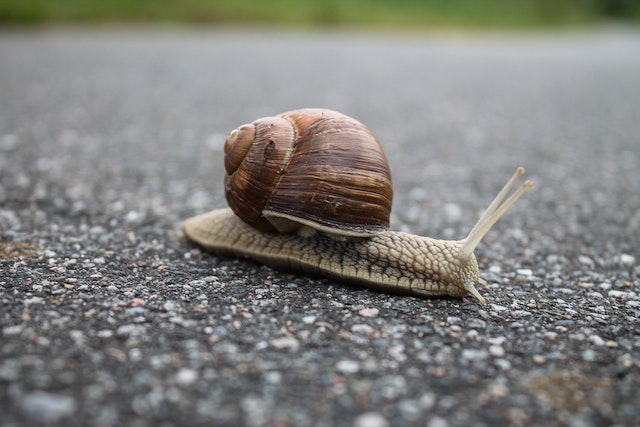
What is the difference between slugs and snails? There are several differences but a big one is that snails have a coiled shell on their backs and slugs have a soft shell underneath their flesh.
Snails and slugs have a lot more similarities than they have differences. Let’s look at the similarities first. Both snails and slugs belong to the mollusk phylum of animals, and they are both gastropods. Mollusk is an enormous group of animals. There are 85,000 different species in this phylum, and it is the second largest group of invertebrate animals. It contains squid, octopuses, shellfish, cuttlefish, and many other invertebrates. Gastropod is another huge group and there are over 40,000 different species of them. So, trying to generalize about slugs and snails is not an easy thing.
The word snail has existed for longer than the word slug. Before the word slug was used, all slugs were called snails. “Snail” comes from the Proto-Indo-European language root “sneg-“, which meant “to crawl, creep; creeping thing”. The same root can be seen in the word “snake”. Slug was first used to refer to the shell-less snails in 1704. It originally meant a lazy or slow-moving person. We can still see it in “sluggish”.
Slugs and snails both move in the same way. They both have a muscular foot. When they want to move, they can contract the muscle in a ripple effect, slowly propelling themselves forward. They also produce a large amount of mucus at the front of the foot. This helps to lubricate their motion and they can also use it to stick themselves to things when they are climbing vertically or upside down. The mucus is produced all over their bodies and stops them from drying out. You can see the dried mucus as the trail the slugs and snails leave. Different snails and slugs travel at different speeds, but the slowest move at 0.0028 m/s. Faster ones can move at about 0.013 m/s.
Both snails and slugs eat in a similar way. They both have a jaw at the front of their foot and a flexible band of thousands of microscopic teeth. This is called a radula and it works almost like a sandpaper tongue, scraping up food particles into the jaw and breaking them down. Some snails can also use their jaw to cut pieces of leaf or other matter up to be broken down by the radula. They both eat plant matter, living and dead. They are hated by gardeners because they can destroy a vegetable crop, but they are a vital part of the ecosystem because they are decomposers that also eat dead leaves and dead insects.
Both slugs and snails have compound eyes at the end of the stalks on their heads. They don’t have muscles to focus these eyes and can only really see light and dark. They also have antennae that they use for sensing odors and vibrations.
So, how are they different? There are three main differences. The first is their speed. Slugs tend to be slower than snails. The second difference is when they are active. Slugs tend to be active at night or they stay in cool and dark places. Slugs are often found in moist places, such as moss, tree bark, damp refuse, and rotting trees. Snails also like cool and dark places, but they are more active in the daytime. This is down to the snail’s shell. The shell serves some protection from the sun, whereas slugs are more likely to dry out in direct sunlight. They both like to come out after it has rained.
The third difference is probably the biggest and the most obvious. Snails have coiled shells on their backs. Snails make their shells in the same way that shellfish make their shells. They have an organ called a mantle that secretes layers of calcium carbonate. The mantle produces an electric current that pushes calcium ions into the place they are supposed to be. This crystalizes and becomes the shell. This shell produces a slight difference in what snails and slugs eat. Snails need a lot more calcium than slugs and they get this by eating spinach, broccoli, turnips, or other vegetables with a lot of calcium. They also get it from the soil or limestone. Snails use their shells as protection from the sunlight and as a place to hide. They can fit their entire body in it and some snails can seal up the entrance with mucus.
That is not to say that slugs don’t have shells. Many slug species has a shell that they have internalized. It is inside their backs. They produce it in the same way as the snail, but they don’t use it for protection. It is used as a way to store calcium. So, snails and slugs seem to have a lot more similarities than they do differences. And this is what I learned today.
Photo by invisiblepower: https://www.pexels.com/photo/close-up-of-snail-on-ground-320956/
Sources
https://molluscs.at/gastropoda/index.html?/gastropoda/morphology/nutrition.html
https://redbuttegarden.org/gardening-information/slugs-and-snails/
https://a-z-animals.com/blog/slug-vs-snail-the-3-key-differences-explained/
https://www.diffen.com/difference/Slug_vs_Snail
https://agsci.oregonstate.edu/slug-portal/identification/common-species
https://www.etymonline.com/word/snail
https://www.etymonline.com/word/slug
https://www.discoverwildlife.com/animal-facts/insects-invertebrates/how-do-slugs-and-snails-move/
https://www.discoverwildlife.com/animal-facts/insects-invertebrates/what-is-snail-slime/
https://hypertextbook.com/facts/1999/AngieYee.shtml
https://a-z-animals.com/blog/snail-eyes-everything-you-need-to-know/
https://animals.howstuffworks.com/marine-life/do-snails-get-shells.htm
